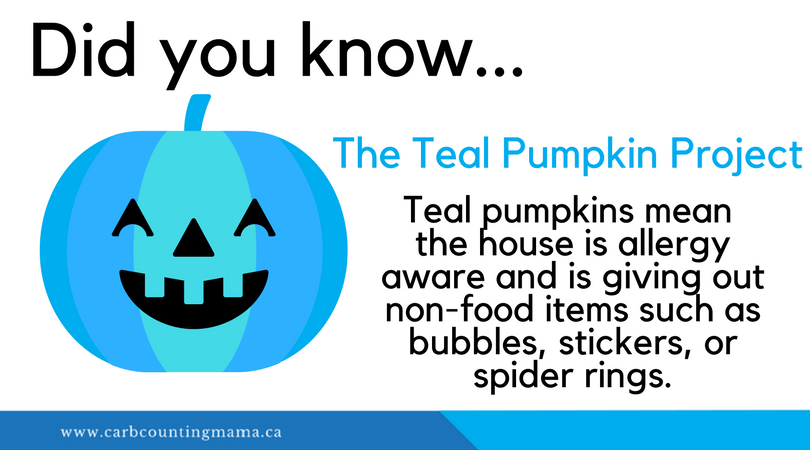Your child has been diagnosed with type 1 diabetes and Halloween is fast approaching. You have been concerned about what to do with all the candy. Should you skip trick or treating entirely? Should you go anyway to allow your child to feel more “normal”?
When you ask more experienced T1 parents how to approach trick or treating with T1D, you are met with an overwhelming, “do what you did before diagnosis. Go trick or treating. Let them be a kid.” But to a parent of a newly diagnosed T1 kiddo, that can be a scary concept. How exactly do you do what you did before while managing T1D?
Here are some tips and tricks that will allow you and your child to enjoy Halloween, even with T1D tagging along.

(This article contains affiliate links)
When my son was diagnosed with diabetes, one of the first things I asked in my state of utter shock was, “will he still be able to go trick or treating?” I was told yes, but I couldn’t fathom how it would be possible.
As we know, type 1 diabetes is not caused by eating too much sugar. Also contrary to popular belief, having T1D does not cause you to have to limit your carb or sugar intake.
So the short answer is… yes, you can go trick or treating. However, as with everything else T1-related, it’s always good to be prepared.
Before you go trick or treating
- Make sure your child’s costume allows you to access diabetes devices if needed.
- Bring their blood glucose monitor or check their CGM often. Trick or treating usually involves a lot of walking. It’s similar to the exercise they might get in gym class or during sports. You may have to stop to do a bg check (or two or three) while you’re out.
- Speaking of bg checks: yes, it’s ok to do it right on the sidewalk surrounded by other trick-or-treaters. Don’t let strangers make you feel bad for tending to your child’s medical needs.
- Talk to your child about what will happen with their candy after trick or treating is done. If possible, discuss different options and come up with a plan together.
- Download the Halloween Candy Carb Chart printable from Beyond Type 1 (or another similar printable) and keep it somewhere handy. Waltzing the Dragon also has a Canadian Carb Treats List. We like putting it on the fridge!
While you are trick or treating
If your child is out trick-or-treating, walking from house to house for hours, they may end up with low blood sugar.
Luckily, you’re out collecting candy. You have lots of perfect low treatments!
Or do you?
Remember, just as not all carbs are created equal, not all candy is created equal.
Some are good for low treatments, while others are not. Take Smarties for example. Canadian Smarties are candy-coated chocolates. Those are not the best low treatment because chocolate is more complex than glucose. Smarties in the US, on the other hand, are chalky candy similar to dex tabs. These are perfect for low treatments!

Simple glucose is the best form of carbs to bring up a low blood sugar. Check out your child’s trick-or-treat bucket for sugary candies such as skittles, rockets (smarties in the US), or candy corn. You may also come across a juice box or can of pop along your travels, these are also great for lows.
To treat a low, stay away from candies that have chocolate, peanut butter, cookie, or any other more complex carbs. They take longer to break down in the body and will not bring up the blood sugar as quickly.
However, to keep a good bg in range while you’re walking around, a fun-size Snickers, Kit Kat, or Twix does the trick for many people.
What to do with the candy once you’re back home
First, you’ll probably be like most parents and want to look through their stash before they have any. In our house, the Reese’s seem to disappear during that phase… someone has to make sure they haven’t been poisoned!
While doing this, many T1D parents will also separate the “good low treatments” from the other candy and save them for lows.
So, what should you do with the candy? Here are a few options:
- Let your child have a set number of pieces when you get home, then set a number of “treats” they can have each day until they’re gone. This is easy to bolus for if you have a carb ratio and it’s also simple to sneak a treat or two in with regular meals if you’re using a sliding scale or carb targets.
- Free for all. They can pick what they want, as long as they show you what they’re having so you can add it up and bolus for it. If you’re on a sliding scale or using carb targets, talk to your diabetes team in advance to come up with a plan on how to bolus for the candy.
- Have your child pick 10 pieces to keep, and trade the rest for a toy or experience.
- Trade it in. Some stores and dentist offices will pay your child money for their candy.
- You could find a place to donate it (such as a children’s ward of a hospital or a senior center). Just check with places ahead of time to make sure they will accept it.
- Some people do the “Switch Witch” or the “Halloween Fairy”. You leave the candy out on the porch on Halloween night and in the morning there is a toy in its place! Super fun!

Extra tips for trick or treating with T1D
- As mentioned above, candy tends to work quickly in your system. If you give your child candy with a well-balanced snack or meal (including fat and protein), it is less likely to cause a spike in blood sugar. Alternatively, knowing how to pre-bolus for different macro profiles comes in very handy.
- “Let them be a kid” doesn’t mean giving them free rein. You can put limits and rules in place as you would any non-T1 child. For instance, you could limit the amount of candy they can have at one time, or let them know that there are times they are not allowed to have candy (like before dinner).
- Halloween is a good time to discuss moderation. Just because they can eat all of their candy at once, doesn’t mean they should. And if you want to let them eat loads of candy, talking about how their body feels after can be really eye-opening.
- If you don’t want to trick or treat, you don’t have to. There are plenty of other things you can do for Halloween. Pools often have a Halloween Swim. Corn mazes, haunted houses, pumpkin patches, hay rides… Halloween isn’t all about trick or treating.
- Look for houses with teal pumpkins. Here is a cute teal pumpkin sign you can purchase if you’d like to hand out non-food items this Halloween.
Trick or treating with T1D doesn’t have to be a scary experience. Hopefully, these tips and options have eased your mind a bit about managing T1D this Halloween.
~ Leah
What do you do for Halloween? Do you go trick or treating? Does the “Switch Witch” visit your house? Share your T1D trick-or-treating tips in the comments!!
For more tips and stories about T1D, join the Carb Counting Mama email list, and make sure to head over to the Carb Counting Mama Facebook page and “like” it.
Great Post!
One tiny remark – Play-Doh actually contain gluten (Wheat) and is not a good option for kids with Celiac. Therefore- probably not a good idea if you’re doing “Allergy free” treats.
Thank you! My child has T1 but no allergies. I don’t know why it didn’t occur to me how Play-Doh is made… I’ve made it before. I will update it to take that out. I appreciate you pointing that out! 🙂